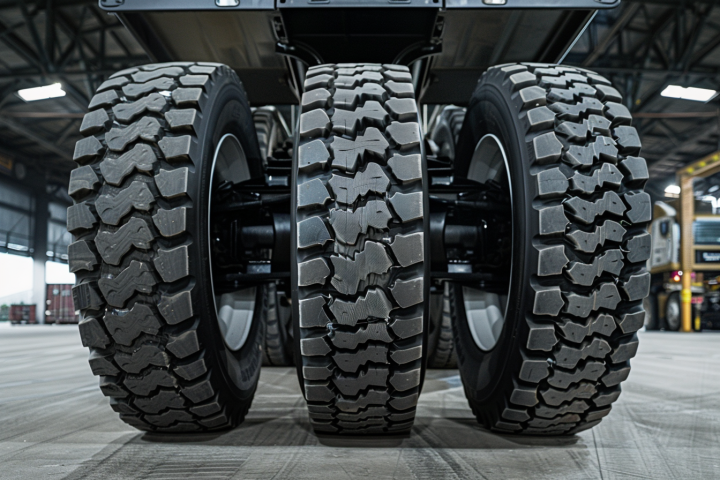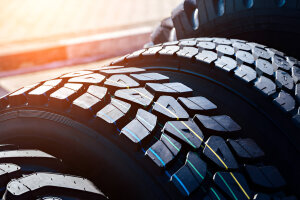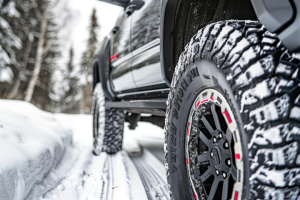Last Updated on August 28, 2024
Introduction To Tire Lifespan
Welcome to our comprehensive guide on the importance of tire lifespan for trucks, presented by Tires Easy Truck. In this introduction, we will delve into why understanding and managing the lifespan of your truck tires is not just a matter of maintenance but a crucial aspect that affects safety, performance, economics, and environmental impact. Additionally, we will outline the objectives of this guide to help you, as truck owners and operators, navigate the complexities of tire lifespan management effectively.
Overview of Tire Lifespan Importance
Since a truck’s tires are the only part of the vehicle that makes contact with the road, they are essential to its overall performance and safety. A good-rest tire offers the best possible traction, handling, and braking capabilities to safeguard the truck driver, the load, and other drivers on the road. On the other hand, tires that are worn out or improperly maintained can cause loss of control, greater stopping distances, and a higher chance of collisions.
The state of a truck’s tires dramatically impacts its performance in terms of weight carrying and gasoline efficiency. Optimized tread depth and proper inflation on well-maintained tires can lower rolling resistance and increase fuel efficiency. This is especially important for commercial trucks, as fuel bills comprise a large portion of operating costs.

Economic and Environmental Implications of Tire Lifespan
The longevity of truck tires directly affects the economy. Over time, improving the lifespan of tires through good maintenance can result in significant cost savings, as tires are an expensive investment. However, skipping tire care can lead to more frequent replacements, more downtime, and possibly more costly repairs because of tire-related issues.
Tires’ impact on the environment is a significant yet sometimes disregarded factor. Tire manufacturing and disposal are two ways environmental pollution is caused. Truck owners can lessen their environmental impact by reducing the frequency of tire replacements and increasing their tires’ lifespan via regular care and maintenance. Because used tires don’t biodegrade, this method helps prevent their accumulation, a significant environmental concern. It also conserves resources.
Objectives of the Tire Lifespan Guide
This guide aims to provide truck owners with comprehensive information on the variables influencing tire lifespan. We strive to inform you how various driving situations, upkeep procedures, and tire types might affect how quickly your truck’s tires deteriorate. By being aware of these factors, you can ensure your truck’s best possible performance and safety by making educated tire replacements and maintenance decisions.
The main goal of this guide is to encourage the trucking sector to use tires safely and effectively. Our goal is to draw attention to the finest tire care procedures, which include routine examinations, appropriate inflation, and prompt replacement. These procedures improve security and boost the general effectiveness of truck operations. Truck owners and operators can preserve the life of their tires, save operating expenses, and positively impact a safer and more sustainable trucking environment by following the advice in this book.
Understanding Tire Basics
Understanding the basics of truck tires is crucial in truck operations. Tires are more than just rubber; they are complex components essential to trucks’ safety, efficiency, and performance. In this section, we will explore the composition and design of truck tires and delve into the various types of truck tires and their specific uses.
Composition and Design of Truck Tires
Truck tires are carefully designed to handle oversized loads and a range of driving circumstances. They usually have reinforced sidewalls and unique tread patterns for increased durability and traction. Truck tires frequently combine materials like steel, rubber, and cutting-edge synthetic compounds for the best results.
Material Composition
Truck tires are usually made from a combination of natural and synthetic rubber, steel, fabric, and different chemical compounds. In addition to adding strength and longevity, the steel and fabric (often nylon, polyester, or Kevlar) inside the tire are essential for providing the required traction. These materials are made to endure harsh environments, lengthy travel times, and large weights.
Design Features
The design of a truck tire is complex, with each part serving a specific purpose:
- Tread: The tread is the part of the tire that comes into contact with the road. It is designed with specific patterns that suit different driving conditions. The depth and pattern of the tread affect traction, fuel efficiency, and noise levels.
- Sidewalls: The sidewalls protect the sides of the tire from damage and impact. They also contribute to the tire’s load-carrying capacity and ride quality.
- Beads: Beads are steel wires coated in rubber that hold the tire onto the rim. They ensure an airtight fit and provide structural integrity.
- Belts: Belts are layers of steel, polyester, or other materials beneath the tread that add stability and strength to the tire.
Different Types of Truck Tires and Their Uses
There are several varieties of truck tires, each designed to meet a particular purpose. All-terrain tires offer adaptability for both on- and off-road use, while highway tires deliver smooth, effective performance on paved roads. Mud tires are perfect for off-road situations because of their abrasive tread patterns, and snow tires are made to provide the most possible traction during cold weather.
- All-Season Tires
All-season tires are designed to perform well in various conditions, including dry roads, rain, and light snow. They are a popular choice for many truckers due to their versatility. - Highway Tires
These tires are designed for long-distance travel on highways. Their tread pattern is usually optimized for smooth, dry surfaces, offering a comfortable ride and good fuel efficiency. - Off-Road Tires
Off-road tires are built for rough terrain and unpaved surfaces. They have deeper treads and more aggressive patterns to provide better traction on mud, gravel, and sand. - Winter Tires
Winter tires are essential in regions with severe winter conditions. They are made from a softer rubber compound that remains flexible in cold temperatures, providing a better grip on ice and snow. - Fuel-Efficient Tires
These tires are designed to reduce rolling resistance, which improves fuel efficiency. They are suitable for long-haul trucks where fuel economy is a significant concern. - Heavy-Duty Tires
Heavy-duty tires are designed for heavy loads and harsh working conditions. They are often used in construction, logging, and other industrial applications.
Truck owners and operators must comprehend truck tires’ types, composition, and designs. Every kind of tire has a distinct function, and selecting the proper one can significantly impact a truck’s efficiency, safety, and performance. By being informed about the basics of truck tires, you can make better decisions for your truck fleet, ensuring optimal performance and safety. Tires Easy Truck is committed to providing in-depth knowledge and high-quality tire options to meet the diverse needs of the trucking industry.
Factors Affecting Tire Lifespan
For truck owners and operators, maximizing tire performance and cutting expenses require understanding the variables influencing tire lifespan. This section will examine several significant variables affecting truck tires’ longevity, including environmental influences, driving patterns, cargo and distribution, and road conditions.
Road Conditions and Tire Wear
Road conditions can affect tire wear, with rough or uneven surfaces causing more rapid deterioration. Potholes, sharp objects, and extreme temperatures can lead to irregular wear patterns, reducing tire life and potentially impacting vehicle safety.
Surface Roughness and Debris
Uneven terrain, potholes, and rough road conditions can cause tire wear and tear. These circumstances frequently cause irregular tread wear, cuts, and punctures.
Traveling on these types of surfaces frequently can shorten tire life.
Road Type and Usage
Highway driving usually results in more even wear because of the smoother, more uniform surfaces.
City driving can accelerate tread wear because of frequent stops and starts.
Impact of Truck Load and Distribution
The load and distribution of the truck significantly impact tire performance and wear. Excessive or uneven loading can put undue strain on some tires and cause uneven tire wear, hurting safety, handling, and fuel economy.
Weight Load
The weight a truck carries significantly affects tire lifespan. Overloading a car puts extra pressure on the tires, increasing wear and potential structural damage.
Adhering to recommended load limits is crucial for maintaining tire integrity.
Load Distribution
Tire wear can be uneven due to an uneven distribution of loads. Proper load balancing distributes the weight evenly across all tires, decreasing the risk of early tire wear.
Influence of Driving Habits on Tire Longevity
Tire lifespan is significantly impacted by driving patterns. Excessive tire wear can result from aggressive driving, which includes abrupt bends, harsh braking, and fast acceleration. Maintaining optimal performance and extending tire life are made possible by consistent, smooth driving.
Driving Style
Aggressive driving can accelerate tire wear, including harsh braking, fast acceleration, and sharp turns.
Tire life can be increased by using smooth, regular driving techniques.
Speed
High-speed driving increases tire temperature, leading to faster degradation of the tire materials.
Maintaining moderate speeds is advisable for prolonging tire life.
Environmental Factors and Their Effects
Environmental factors like temperature, humidity, and road salt can affect tire conditions. Extreme temperatures can alter tire pressure and flexibility, while humidity and corrosive materials like road salt can accelerate tire aging and wear.
Temperature Fluctuations
Extreme temperatures, both hot and cold, can affect tire longevity. While cold can make tires brittle and more prone to damage, heat can cause the rubber to expand and wear down more quickly.
It is essential to use and store tires appropriately for the given season.
Exposure to Elements
Prolonged exposure to sunlight and moisture can deteriorate the rubber compounds in tires.
Storing trucks in a sheltered environment when not in use can help protect the tires.
Truck owners and operators should take proactive measures to maximize tire life by being aware of the various elements that affect truck tire longevity. To ensure the longevity and safety of truck tires, it is essential to comprehend and mitigate the effects of multiple factors, including driving habits, environmental exposure, load management, and road conditions.
By paying attention to these aspects, truck operators can achieve better performance, reduce costs, and enhance safety on the road. Tires Easy Truck is dedicated to providing valuable insights and quality tire solutions to support the trucking community in effective tire management.

Signs of Tire Wear and Replace Needs
Recognizing when to replace tires is critical for truck operators to maintain safety, efficiency, and compliance with regulations. This section of our guide focuses on identifying signs of tire wear and understanding when tire replacement is necessary. We will cover visual indicators, performance issues, and the safety hazards of worn tires.
Visual Indicators of Tire Wear
Key visual indicators of tire wear include uneven tread wear, visible tire wear bars, cracks or cuts in the sidewall, and bulges or blisters on the tire surface. These signs suggest that the tires must be inspected or replaced to ensure safe driving conditions.
Tread Depth
The most apparent indicator of tire wear is the depth of the tread. A tread depth gauge can measure it. The legal minimum tread depth for trucks in most regions is 1/16th of an inch. When treads wear down to this level, it’s time for replacement.
Wear Patterns
Uneven wear patterns such as cupping, feathering, or bald spots indicate alignment issues, suspension problems, or improper inflation. These irregular wear patterns can signal the need for tire replacement and potentially for the truck’s mechanical adjustments.
Sidewall Checks
Inspecting the sidewalls for cuts, cracks, bulges, or blisters is essential. Damage to the sidewall can weaken the tire, making it susceptible to blowouts.
Performance Issues Signaling Tires Replace
Reduced traction or grip, particularly in wet situations, longer stopping distances, and a discernible drop in ride comfort are performance problems that indicate tire replacement is necessary. Vibrations or strange noises may also be signs of tire issues when driving.
Vibration and Ride Comfort
Excessive vibration or a change in ride comfort often indicates tire issues. While some vibrations can be due to alignment or balance issues, they can signal internal tire damage that necessitates replacement.
Air Pressure Loss
When air pressure is frequently lost, it indicates slow leaks, which can be due to tire damage. Regularly inflating tires is a sign that the tire may need to be replaced.
Traction and Handling Difficulties
A decrease in traction, especially in wet conditions, or difficulty handling can be a sign of worn treads. Tires with insufficient tread depth will not provide adequate grip, increasing the risk of accidents.
Safety Hazards of Worn Tires
Worn tires provide serious safety issues, such as an increased danger of blowouts and punctures, reduced handling and braking efficiency, and decreased grip in bad weather. This can lead to dangerous situations, especially when traveling quickly or in challenging weather.
Increased Risk of Blowouts
Worn or damaged tires are more prone to blowouts, which can be catastrophic, especially at high speeds. Regular inspections and timely replacement of worn tires are essential for preventing such dangerous situations.
Longer Braking Distances
Worn tires can significantly increase braking distances, particularly in wet conditions, leading to an increased risk of collisions.
Hydroplaning
Tires with low tread depth are more likely to hydroplane in wet conditions. Hydroplaning occurs when a layer of water builds between the road surface and the tire, leading to loss of traction and control.
Truck drivers and fleet managers have essential duties in keeping an eye on and identifying the indicators of tire degradation. You can guarantee prompt tire changes, preserve safety and performance on the road, be watchful for visual cues and performance problems, and know the safety risks associated with worn tires. Every truck should have routine tire checks as part of its maintenance schedule. At Tires Easy Truck, we emphasize the importance of tire safety and offer a range of quality tires suitable for various trucking needs. This ensures you can always find the right tire when replacement becomes necessary.
Optimal Tire Maintenance Practices
Maintaining truck tires is essential to guaranteeing performance, safety, and economy in the trucking sector. This section of our book focuses on the best tire care procedures that truck owners and operators should adhere to. We’ll review the significance of routine maintenance, tire rotation, appropriate inflation, and handling minor tire damage.
Regular Inspections and Tire Rotation
Regular tire inspections and rotation are crucial for even tire wear and prolonged tire life. As the manufacturer recommends, rotating your tires helps ensure uniform wear across all tires, improving handling and fuel efficiency.
Frequency of Inspections
Regular tire inspections should be conducted before and after each trip. This includes checking the tire’s condition, tread depth, and air pressure.
Inspections should be performed monthly, including checking for wear patterns and potential issues.
Tire Rotation
Regular tire rotation involves moving tires to different positions on the truck. This practice ensures even wear on all tires, extending their lifespan.
Tire rotation should follow the manufacturer’s recommendations and industry best practices, which vary depending on the type of tires used.
Benefits of Inspections and Rotation
Tire problems can be identified early on to avoid expensive repairs and collisions.
Even tire wear enhances handling, fuel economy, and ride quality.
Proper Tire Inflation and Its Benefits
Sustaining appropriate tire pressure is crucial for maximum tire longevity and performance. Properly inflated tires improve handling and braking performance, lower the chance of tire damage, and increase fuel efficiency.
Maintaining Proper Inflation
Regularly check and maintain the correct tire inflation pressure, as specified by the truck manufacturer and tire manufacturer.
Proper tire inflation is crucial for load-carrying capacity, fuel efficiency, and safety.
Benefits of Proper Inflation
- Improved Fuel Efficiency: Under-inflated tires increase rolling resistance, decreasing fuel efficiency.
- Extended Tire Lifespan: Properly inflated tires experience less heat buildup, reducing tire wear and extending lifespan.
- Enhanced Safety: Properly inflated tires provide better traction and handling, reducing the risk of accidents.
Tire Pressure Monitoring Systems (TPMS)
Consider installing TPMS to monitor real-time tire pressure, especially for long-haul trucks. TPMS can promptly alert you to pressure deviations.
Dealing with Minor Tire Damages
Minor tire damage, such as small cuts or punctures, should be promptly repaired to stop further degradation. Although it is vital to replace tires if the damages are significant or in essential locations, using professional repair services for minor damages can prolong tire life and ensure safety.
Punctures and Repairs
If a tire sustains a puncture, assess its size and location. Small punctures in the tread area can often be repaired safely.
You should perform repairs by trained professionals using industry-standard repair methods.
Avoiding Overloading
It is best not to overload a truck because it can damage tires, especially on rough terrain. Ensure your truck’s load is within the recommended weight limits to avoid unnecessary wear and tear.
Avoiding Curbing
Avoid hitting curbs or obstacles when parking or maneuvering your truck. Such impacts can damage the tires’ sidewalls, leading to structural weaknesses.
Truck owners and operators must implement the best tire maintenance methods. Tire longevity, safety, and general efficiency can all be significantly impacted by performing routine inspections, rotating tires, properly inflating them, and taking care of minor damage. You may maximize the performance of your truck tires, lower operating costs, and improve safety by carefully adhering to these principles. To help the trucking industry optimize tire maintenance procedures, Tires Easy Truck is committed to providing premium tires and insightful maintenance advice.
Choosing the Right Replace Tires and Tire Lifespan
Selecting the right replacement tires for your truck is a crucial decision that impacts safety, performance, and cost-effectiveness. This section of our guide will explore the critical considerations for choosing the right replacement tires. We will cover evaluating tire specifications and ratings, matching tires to truck needs and conditions, and the delicate balance between cost and quality in tire selection.
Evaluating Tire Specifications and Ratings
When analyzing tire specs and ratings, consider variables like load capacity, speed rating, and tread wear grade. These characteristics on the tire sidewall can be used to ascertain the tire’s suitability for a specific vehicle type and set of driving conditions.
Load Index and Speed Rating
A tire’s load index and speed rating indicate its maximum load-carrying capacity and speed capabilities. It is essential to choose tires that meet or exceed your truck’s load requirements and are appropriate for your typical driving speeds.
Tread Depth and Pattern
The tread depth and pattern influence traction, handling, and performance in various road conditions. Consider the terrain your truck will encounter and choose tires with the appropriate tread design and depth.
Ply Rating
Ply rating or tire construction type (radial or bias-ply) affects a tire’s load-carrying capacity and durability. Ensure the tires you choose suit the weight your truck carries.
Matching Tires to Truck Needs and Conditions
When matching tires to truck needs, one must consider the load capacity, driving conditions, and truck usage. For example, trucks operating in different terrains might benefit from all-terrain tires, whereas heavy-duty trucks might need tires with higher weight ratings.
- Truck Usage
Consider your truck’s primary use. Is it for long-haul highway driving, off-road applications, or a combination? Different tire types are designed for specific usage scenarios.
- Climate and Weather
Your operating area’s climate and weather conditions significantly affect tire selection. For harsh winters, winter tires may be necessary for safety and traction.
- Terrain
If your truck frequently encounters rough terrain or construction sites, consider all-terrain or off-road tires designed to withstand such conditions.
- Load Distribution
Ensure that the replacement tires can handle your truck’s load distribution. Uneven load distribution can lead to tire wear issues.
Balancing Cost and Quality in Tire Selection
Balancing cost and quality in tire selection is critical to ensuring value for money. While premium tires may offer better performance and longevity, mid-range tires can provide a good balance of quality and affordability, especially for moderate or light truck usage.
- Budget Considerations
While quality is essential, staying within your budget is also important. Determine your budget for tire replacement and explore options that offer the best balance of cost and quality.
- Total Cost of Ownership
Consider the long-term costs associated with your tire choice. High-quality tires may have a higher upfront cost but can provide better fuel efficiency and longer lifespan, reducing the total cost of ownership over time.
- Warranty and Support
Check the warranty and support offered by the tire manufacturer and retailer. A reliable warranty can provide peace of mind and assistance in case of defects or issues.
Choosing the right replacement tires for your truck is a decision that should be made with careful consideration of your specific needs, operating conditions, and budget. By evaluating tire specifications, matching tires to your truck’s requirements, and striking the right balance between cost and quality, you can ensure your car performs optimally, maintains safety standards, and remains cost-effective in the long run. At Tires Easy Truck, we offer a wide range of high-quality tires and expert guidance to help you make the best choice for your trucking needs.
Legal and Regulatory Considerations
Legal and regulatory issues are crucial when it comes to truck tires. Following tire-related rules and safety standards is not only legally required but also essential to guarantee the safety and compliance of your vehicle operations. This portion of our book will cover the ins and outs of truck tire laws and the importance of adhering to safety requirements.
Understanding Tire-Related Regulations for Trucks
Rules about truck tires usually cover tread depth, tire size, load capacity, and pressure limitations. These laws, which differ by area and are intended to guarantee safe vehicle operation and road safety, should be known to truck drivers.
- Load Limits
Federal and state regulations specify truck load limits, including axle weight limits. It is crucial to ensure that your tires and overall vehicle load do not exceed these limits.
Overloading can lead to tire damage, safety hazards, and legal consequences.
- Tire Size and Specifications
Regulations likewise govern the dimensions and characteristics of tires appropriate for various truck models. To stay compliant, make sure your replacement tires adhere to these requirements.
Fines and penalties may be imposed for noncompliance.
- Tire Tread Depth
Many jurisdictions have minimum tread depth requirements. Tires with tread depths below the legal limit are considered unsafe and may lead to citations or accidents.
Regularly monitor and replace tires that do not meet tread depth requirements.
Compliance with Safety Standards
Compliance with safety standards in truck tires involves adhering to legal requirements for tire condition, tread depth, and pressure. Regular inspections and maintenance are crucial to meet these standards, thus ensuring the safety of the vehicle, its cargo, and other road users.
- Safety Inspections
Routine safety inspections are a legal requirement for commercial vehicles. These inspections include checking the condition of tires, brakes, lights, and other safety-related components.
Ensuring that your tires are in good condition and meet safety standards is essential for passing these inspections.
- Tire Maintenance Records
Compliance requires keeping thorough records of tire inspections and maintenance. These documents attest to the adherence to safety regulations.
Additionally useful in the event of disputes or audits are accurate records.
- Emergency Equipment
Safety rules may require trucks to carry emergency supplies, such as extra tires. Ensuring your light tires are legally compliant and in good working order is crucial.
Having a suitable spare tire will save you time and money should you experience a tire failure while driving.
- Tire Chains
Tire chain regulations may apply during certain times of the year in regions with winter weather conditions. Ensuring that your tires are compatible with tire chains and complying with chain requirements is necessary for safety and legal reasons.
At Tires Easy Truck, we prioritize safety and compliance and provide guidance and resources to support trucking professionals in meeting legal and regulatory obligations.
The Environmental Impact of Tire Disposal

Responsible Disposal of Worn Tires
Properly managing used tires is essential to reducing the adverse environmental effects, as tire disposal is a primary environmental concern. This portion of our book will examine the impact of tire disposal on the environment and appropriate disposal techniques and choices for recycling and reusing old tires.
Wearing out tires responsibly means bringing them to tire disposal facilities or specific recycling locations. This guarantees that the tires are treated by local laws and environmental requirements, preventing environmental harm.
- Avoiding Illegal Dumping
Dumping tires illegally is harmful to the environment and illegal in many regions. Disposing of tires in unauthorized areas can result in fines and penalties.
Ensure your worn tires are disposed of through legitimate channels, such as authorized disposal facilities.
- Tire Retailer Programs
Many tire retailers offer tire disposal services when you purchase new tires. This ensures that your old tires are correctly disposed of or recycled.
Take advantage of these programs to contribute to responsible tire disposal.
- Tire Collection Events
Some communities organize tire collection events where residents can drop off old tires for proper disposal or recycling. Participating in such events is an environmentally responsible choice.
Recycling and Reuse Options for Old Tires
Old tires can be recycled and reused into rubber mulch for landscaping, building materials, or a foundation for freshly painted roads. Certain tires are recycled to make commonplace objects like playground flooring, shoes, and artwork.
- Tire Recycling
Recycling your old tires is an effective way to reduce environmental impact. Tires can be recycled into various products, including rubberized asphalt, playground surfaces, and new tires.
Support tire recycling initiatives and choose products made from recycled tire materials when possible.
- Retreading Tires
Retreading is a process in which the worn tread of a tire is replaced with a new tread. It extends the tire’s life and reduces the demand for new tire production.
It would be best if you considered retreading as an eco-friendly and cost-effective option for extending the life of truck tires.
- Creative Reuse
Old tires can be creatively repurposed for various uses, such as garden planters, swings, or furniture. These DIY projects reduce waste and add a touch of sustainability to your surroundings.
- Energy Recovery
Old tires can sometimes be energy sources through tire-derived fuel (TDF) processes. TDF can replace traditional fossil fuels in specific industrial applications.
It would be best to look for opportunities for responsible energy recovery from old tires.
There is an urgent need to reduce the adverse effects of tire disposal on the environment. The environmental impact of worn tires can be decreased by using creative solutions, tire recycling, responsible disposal techniques, and reuse alternatives. Our duty as truck owners and operators is to support sustainability and save the environment for coming generations by selecting environmentally suitable tire disposal and recycling practices. Tires Easy Truck offers information on ecologically friendly tire disposal choices and encourages proper disposal.
Conclusion & Recommendations
In conclusion, ensuring the optimal lifespan of your truck tires is not just a matter of cost savings; it’s a fundamental aspect of safety and efficiency in the trucking industry. Throughout this comprehensive guide, we’ve explored various facets of truck tire maintenance, from understanding the factors affecting tire lifespan to choosing the right replacement tires and considering environmental impacts. Let’s recap the key points and final recommendations for effective truck tire maintenance.
Recap of Key Points
The critical points in truck tire maintenance include regular inspections for wear and damage, ensuring proper inflation, rotating tires for even wear, and choosing the right tires for specific truck needs and conditions. Additionally, adhering to safety standards and being aware of environmental considerations in tire disposal are crucial.
- Understanding Tire Basics: We began by delving into the composition and design of truck tires, the different types, and their specific uses. Knowing your tires is the first step in proper maintenance.
- Factors Affecting Tire Lifespan: We discussed how road conditions, truckload and distribution, driving habits, and environmental factors all play a role in determining the lifespan of your tires.
- Signs of Tire Wear and Replacement Needs: Recognizing visual indicators of tire wear, performance issues signaling replacement, and safety hazards associated with worn tires is vital for timely replacements.
- Optimal Tire Maintenance Practices: We emphasized the importance of regular inspections, tire rotation, proper inflation, and addressing minor damages as essential practices to extend tire life.
- Choosing the Right Replacement Tires: Selecting tires that match your truck’s needs, terrain, and budget is crucial. Evaluate tire specifications, consider load limits, and balance cost and quality when choosing.
- Legal and Regulatory Considerations: Complying with tire-related regulations and safety standards and conducting routine inspections is essential to avoid legal consequences and ensure safety on the road.
- Environmental Impact of Tire Disposal: We explored the ecological consequences of improper tire disposal and highlighted responsible disposal practices, recycling options, and creative reuse ideas.
Final Recommendations for Truck Tire Maintenance
For the best truck tire care, rotate tires according to the manufacturer’s recommendations, check tread depth and tire pressure frequently, quickly repair any damage, and replace tires as needed. Keep up with tire-related laws and invest in high-quality tires that fit your truck’s specifications.
- Routine Inspections: Make regular tire inspections a standard practice. Monitor tread depth, tire pressure, and overall tire condition before and after trips.
- Proper Tire Rotation: Follow manufacturer recommendations for tire rotation to ensure even wear and extend tire life.
- Maintain Proper Inflation: Keep your tires inflated according to manufacturer and truck specifications. Consider investing in a tire pressure monitoring system (TPMS) for real-time monitoring.
- Address Minor Damages Promptly: If you encounter punctures or minor damages, have them professionally repaired promptly to prevent further tire issues.
- Choose the Right Tires: When selecting replacement tires, consider load ratings, speed ratings, tread patterns, and terrain conditions to match your truck’s needs.
- Compliance with Regulations: You should stay informed about your region’s tire-related regulations and safety standards. Conduct regular safety inspections to ensure compliance.
- Environmentally Responsible Disposal: Dispose of old tires responsibly through authorized channels, tire retailer programs, or community tire collection events. Consider recycling, retreading, or creative reuse options.
As a final recommendation, we invite you to explore the range of high-quality truck tires available at Tires Easy Truck. Our commitment to tire safety, performance, and sustainability aligns with the principles discussed in this guide. By choosing the right tires and following best practices for tire maintenance, you ensure the longevity of your truck tires and contribute to safer and more eco-friendly trucking operations. Take action today and make the right choice for your truck’s tires.
FAQs
How many years should tires last before replacing the tires?
Tires typically last 6 to 10 years. However, factors like usage and maintenance affect their lifespan. Replace them sooner if you notice signs of wear or aging.
At what age should tires be replaced?
Tire age matters. If your tires are over six years old, consider replacement, even if they look good. Rubber deteriorates with time, affecting safety.
What is the recommended life of a tire?
On average, tires are designed to last 40,000 to 60,000 miles (64,000 to 96,000 kilometers). Regular maintenance is needed to help achieve their recommended lifespan.
How long should tires last on average?
Your tires can last an average of six years, depending on usage, maintenance, and driving conditions.
What is the maximum life of a tire?
While some tires can last beyond ten years, pushing them to their maximum life is not advisable. Over time, safety and performance may deteriorate.
How do I know when my tires need replacing?
It would be best to look for signs like low tread depth, cracks, bulges, or uneven wear. If present, it is time for a replacement to ensure safety and performance.
How many km do tires last?
The typical lifespan of tires is between 64,000 and 96,000 kilometers, depending on factors such as tire type and upkeep.
When should you change all four tires?
Replacing all four tires simultaneously is advised for balanced handling and traction, mainly if one or more are seriously worn. This guarantees reliability and security.











 English
English Français
Français Español
Español